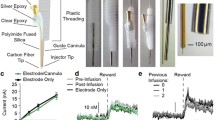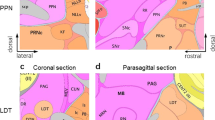Abstract
Macromolecular cholinergic pathways are involved in the regulation of addiction, emotions, and motivations, as described at this ISCM. Indeed, in view of the omnipresence in the brain of cholinergic pathways and of their connections with other transmitters’ sites and pathways, their involvement in all known human and animal behaviors could be expected and numerous current reports describe such cholinergic correlates. This minireview describes the current status and the future of the cholinergic impact on behavior and emotions, and particularly on one important human phenomenon, the “self” or the “I” (it is only speculative to impute the self to animals).

Similar content being viewed by others
References
Ayer AJ (1985) Wittgenstein. The University of Chicago, Chicago
Arnold M (1960) Emotion and personality. Columbia University, New York
Baars J, Dohmen J, Grenier A, Philipson C (eds) (2013) Age, meaning and social structure. University of Chicago, Chicago
Ben-Ami BI, Decely J, Mason P (2011) Empathy and pro-social behavior in rats. Science 334:1427–1430
Butcher LL (1995) Cholinergic neurons and networks. In: Patinos G (ed) The rat nervous system, 2nd edn. Academic, New York
Carter OL, Presli DE, Calistemon C, Lingerer Y, Liu GB, Pettigrew J (2005) Meditation alters perceptual rivalry in Tibetan Buddhist monks. Current Biol 15:412–413
Changeux J-P (2004) The physiology of truth. The Belknap, Cambridge
Changeux J-P (2011) Emergent pharmacology of conscious experience: new perspectives in substance addiction. FASEB J 25:2098–2108
Churchland PM (1995) The engine of reason, the seal of the soul. MIT, Cambridge
Crick F (1994) The astonishing hypothesis. Scribner, New York
Damasio A (2010) Self comes to mind. Pantheon Books, New York
Davis KL, Panksepp J (2011) The brain’s emotional foundations of human personality and the Affective Neurosciences Personality Scales. Neurosci Biobehav Rev 35:1946–1058
Descartes R (1951) Discours de la Methode, Suivi des Meditiations, published originally in 1637. Union Generale d’Editions, Paris
Eccles JC (1979) The human mystery. Springer, Berlin
Eccles JC (1985) Mental summation: the timing of voluntary Intention by cortical activity. Behav Brain Sci 8:542–543
Edelman GM (2004) Wider than the Sky. Yale University, New Haven
Fibiger HG, Damsma G, Day JC (1991) Behavioral pharmacology and biochemistry of central cholinergic neurotransmission. In: Napier TC, Halivas PW, Hanin I (eds) The basal forebrain—anatomy to function. Plenum, New York
Hameroff S, Nip A, Porter M, Tuszynski JA (2002) Conduction pathways in microtubules, biological quantum computation, and consciousness. Biosystems 64:149–168
Hawking S, Mlodinow L (2012) The Grand Design. Kindle Edition, New York
Hodges A (1983) Alan Turing : the enigma. Simon and Schuster, New York
Huxley A (1957) The perennial philosophy. Chatto and Windus, London
James W (1890) The Principles of Psychology, 2 vols. republished in Dover, New York, 950.
Kandel ER (2012) The age of insight. Random House, New York
Karczmar AG (1972) Introduction: what we know, will know in the future, and possibly cannot ever know in neurosciences. In: Karczmar AG, Eccles JC (eds) Brain and Human Behavior. Springer, Berlin, pp 1–29
Karczmar AG (2007) Exploring the vertebrate central cholinergic system. Springer, New York
Karczmar AG (2010) Do all human functions and behaviors, as well as the “self”, have cholinergic correlates? J Mol Neurosci 40:121–126
Karczmar AG (2009) Story of muscarinic receptors, alkaloids with muscarinic significance and of muscarinic functions and behaviors. ARBS Ann Rev Biomed Sci 11:1–50
Karczmar AG (2013) The Unknown ‘I’ (in press)
Konstan D (2006) The emotions of the ancient Greeks: studies in Aristotle and classical Literature. University of Toronto, Toronto
Kramer RS, Weger UV, Sharma D (2013) The effect of mindfulness meditation on time perception. Conscious Cogn 22:846–852
Kurzweil R (2005) The Singularity is Near. Penguin, New York
Libet B (1985) Unconscious cerebral initiative and the role of conscious will in voluntary action. Behavioral Brain Sci 8:529–566
Llinas R (2001) I of the vortex: from neurons to self. MIT, Cambridge
Lutz A, Dunne JD, Davidson RJ (2007) Meditation and the Neuroscience of Consciousness. An Introduction. The Cambridge Handbook of Consciousness 19:490–540
Marx P (2013) Mentally fit, The New Yorker. July 29, pp. 24–28
McGeer PL, McGeer EG, Singh VK, Peng JH (1974) Choline acetyltransferase purification and immunohistochemical localization. Life Sci 34:2319–2338
Mesulam MM (2004) The cholinergic innervation of the human cerebral cortex. Prog Brain Res 245:67–78
Monod J (1970) Le Hazard et la Necessité. Aux Editions du Seuil, Paris
Nagel T (2012) Mind and Cosmos. Oxford University, Oxford
Northoff G, Panksepp J (2009) The trans-species concept of self and the subcortical-cortical midline system. Trends Cogn 18:193–215
Panksepp J (1998) The periconscious substrates of consciousness, affective states and the evolutionary origins of the self. J Consc Studies 5:566–582
Panksepp J (2011) Behavior, empathy and the laws of affect. Science 334:1358–1359
Penrose R (1991) Emperor’s new mind. Oxford University, Oxford
Penrose R (1994) Shadows of the mind. Oxford University, Oxford
Popper KR (1959) The logic of scientific discovery. Rutledge, London
Popper KR, Eccles JC (1977) The self and its world. Springer, Berlin
Revel J-F, Ricard M (1997) Le Moine et le Philosophe. Nil Editions, Paris
Robinson TE, Berridge KC (2003) Addiction. Ann Rev Psychol 54:25–59
Smolin L (2007) The trouble with physics. Spin Networks Ltd., New York
Smythies J (2010) The neural control of mood: the possible role of the adrenergic system in the medulla. Conscious Cogn 20:489–493
Soreq H, Friedman A, Kaufer D (2009) Stress—from molecules to behavior. Wiley Blackwell, New York
Tenzin Gyatso (H. H. Dalai Lama) (1995) The World of Tibetan Buddhism. Wisdom, Boston
Tenzin Gyatso (H. H. Dalai Lama) (2002) Illustrated Teachings of the Dalai Lama. Barnes & Noble, New York
Tronson NC, Schrick C, Guzman YF, Huh KH, Srivastava DP, Penzes P, Guedea AL, Gao CA, Radulovic J (2009) Segregated populations of CA1 neurons mediating conditioning and extiction of contextual fear. J Neurosci 29:3387–3394
Tuszynski JA, Woolf NJ (2006) The path ahead. In: Tuszynski JA (ed) The emerging physics of consciousness. Springer, New York, pp 12–26
Toulmin S (1972) The mentality of man’s brain. In: Karczmar AG, Eccles JC (eds) Brain and Human Behavior. Springer, Berlin, pp 409–422
Turing A (1950) Computing machinery and Intelligence. Mind 236:433–460
Whittaker VP (1992) The cholinergic neuron and its target: the electromotor innervation of the electric ray “Torpedo as a Model”. Birkhauser, Boston
Woolf NJ (2006) Microtubules in the cerebral cortex: role in memory and consciousness. In: Tuszynski JA (ed) The emerging physics of consciousness. Springer, New York
Acknowledgments
The author’s research referred to in this article was supported by grants from NIH, NLM–NIH, GM-NIH, VA, DOD, and the State of Illinois; grants from the Potts, Fidia, CARES of Illinois, and Ballweber Foundations; and by Senior Fulbright and Guggenheim Fellowships. The author wishes also to thank Prof. Karl Tsim, the host of the 14th ISCM, and Dr. Ava Guo, one of the organizers, for their friendship and support, and above all, I wish to thank my old friend, the illustrious scientist and educator, Mona Soreq, for her help with the manuscript.
Author information
Authors and Affiliations
Corresponding author
Rights and permissions
About this article
Cite this article
Karczmar, A.G. Cholinergic Behaviors, Emotions, and the “Self”. J Mol Neurosci 53, 291–297 (2014). https://doi.org/10.1007/s12031-013-0143-0
Published:
Issue Date:
DOI: https://doi.org/10.1007/s12031-013-0143-0




